Babies have lots of fun at bath time, but with any amount of water there's always a risk of drowning. As your baby crawls or toddles around, they may end up other places where there is water, such as swimming pools or lakes.
If you think your baby is drowned, before starting CPR, move them away from the water and lie them on their backs, ideally on a raised surface such as a table. Call for help. Ask a helper to call 999 or 112 for emergency help.
Use a mobile speaker phone if you're on your own, so you can start CPR as soon as possible. If you're on your own and you don't have a speaker phone, you need to do CPR for a minute before you can call for help. Place them on a firm surface and open their airway. With one hand on the forehead, gently tilt their head back, with your fingertip gently lift their chin to open the airway. Pick out any visible obstructions from the mouth and nose.
Step one is puff. Take a breath, put your lips around your baby's mouth and nose and make a seal. Blow gently and steadily for up to one second. The chest should rise. Remove your mouth and watch the chest fall. That's one rescue breath or puff. Do this five times.
Step two is pump or chest compressions. Put two fingers in the centre of your baby's chest and push down a third of the depth of the chest. Release the pressure allowing the chest to come back up, before pressing back down again. Repeat this 30 times at a rate of 100 to 120 pumps per minute. This is quite quick.
After 30 chest pumps, open the airway and give a further two puffs. Continue to alternate between 30 chest pumps and two puffs. If you're on your own and don't have a speaker phone, stop after one minute and call 999 or 112 for emergency help.
If a mobile phone is not available and you have to move to get to a telephone, take the baby with you. Keep repeating 30 pumps then two puffs until help arrives or they become responsive.
If your baby starts to breathe normally again, then we need to put them into the recovery position. Cradle your baby in your arms with their head tilted downwards, then call for an ambulance. Keep checking your child's breathing, pulse and level of response while you wait for help to arrive.
So remember, if your baby's unresponsive and not breathing, call for help. Ask a helper to call 999 or 112 for emergency help. If you're on your own, use a speaker phone and start CPR as soon as possible.
If you don't have a speaker phone, do CPR for a minute before calling for emergency help. Give five initial puffs, covering both the nose and mouth. Then 30 chest pumps with two fingers to the centre of the chest. Continue CPR with 30 pumps to two puffs until help arrives. And that's how you give CPR to a baby that has drowned.
If this video has been helpful to you, help support St John Ambulance by going to sja.org.uk/donate
- 22 views













